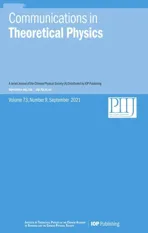The collision frequency of electron-neutralparticle in weakly ionized plasmas with non-Maxwellian velocity distributions
2021-10-13HongWangJiulinDuandRuiHuo
Hong Wang,Jiulin Duand Rui Huo
Department of Physics,School of Science,Tianjin University,Tianjin 300350,China
Abstract The collision frequencies of electron-neutral-particle in weakly ionized complex plasmas with the non-Maxwellian velocity distributions are studied.The average collision frequencies of electron-neutral-particle in plasmas are accurately derived.We find that these collision frequencies are significantly dependent on the power-law spectral indices of non-Maxwellian distribution functions and so they are generally different from the collision frequencies in plasmas with a Maxwellian velocity distribution,which will affect the transport properties of the charged particles in plasmas.Numerically analyses are made to show the roles of the spectral indices in the average collision frequencies respectively.
Keywords: non-Maxwellian velocity distribution,collision frequency,weakly ionized plasma
1.Introduction
Since many physical properties of plasmas depend on collision and collision frequency[1,2],the research on the influence of collision and collision frequency on plasma properties has attracted a large number of scientific researchers,such as Faussurier et al studied the plasma collision frequencies and the related plasma physics[3–5],Tsytovich et al discussed the effect of collisions between dust particles on low-frequency modes and instability in dusty plasma [6],You et al made the measurement and analysis of the electron-neutral collision frequency in the calibration cut-off probe [7],Pecseli et al analyzed the influence of neutral collision on the instability of current-driven electrostatic ion cyclotron [8],and Hahn et al have modeled the collision process in the q-distributed plasma[9].In addition,Khrapak derived the effective ion-neutral collision frequency in flowing plasma [10],Abbasi et al calculated the collision time between plasma and the superthermal particles [11],Wang et al studied collision frequencies of particles in the plasma with power-law q-distribution in nonextensive statistics [12],Sun et al presented the average collision frequency of electron-neutral particle in the weakly ionized plasma with the power-law q-distribution[13]and Kuri et al used mathematical model to simulate the impact of electron–ion collisions on the Weibel stability in the kappadistributed and unmagnetized plasma [14].
The research on the average collision frequency of plasma systems has always been one of the hot issues in plasma physics.The collision phenomenon is one of the most basic characteristics of gas kinetics in plasmas,and transport phenomenon in plasmas is usually related to collision effects [13,15–23],such as the diffusion,the heat conduction and migration and the particle drift in a magnetic field,etc.According to the degree of ionization in a plasma system,it can be divided into weakly ionized plasma,partially ionized plasma and fully ionized plasma.In a fully ionized plasma system,usually we think that electrons and ions are completely separated out and so the collisions of the plasma system are mainly taken place between the charged particles [15].In a weakly ionized plasma system[13,16–23],there are neutral particles,ions and electrons,so there are electron-neutral particle collisions,ion-neutral particle collisions,and extremely few charged particle collisions such as electron–ion collisions and electron–electron collisions and ion–ion collisions.Since the collisions between electrons and neutral particles are the main kinetic mechanism for the weakly ionized plasma,it is of great significance to study the average collision frequency of electron-neutral particle collisions [7].
In nonextensive statistical mechanics,the particle velocity distribution function is the non-Maxwellian distribution or the power-law q-distribution,which describes the complex plasma being in a non-equilibrium state [24–27].In many situations for astrophysical and space plasmas,the velocity distributions appear reasonably Maxwellian at low energies but have a‘superthermal’ power-law tail at high energies.In 1968,Vasyliunas introduced a non-Maxwellian empirical function to simulate the velocity distribution of high-energy electrons in the plasma magnetic sheath,which is the so-called kappa-distribution (or Vasyliunas distribution) [28].The spacecraft measurements of the plasma velocity distribution in the solar wind,planetary magnetosphere and magnet field have showed that non-Maxwellian distributions are very common.In physics,astronomy,chemistry,biology and even social systems,non-Maxwellian distributions or power-law distributions are ubiquitous[29–31].Therefore,the theoretical and experimental works of these distributions and their applications have attracted great attention in various of fields such as astronomy and astrophysics[32–36],plasmas and space physics[22,29,30,32,37,38],and reaction rate theory in chemistry [39–41],etc.
There are many space plasma phenomena,such as interstellar medium,thermo-ionosphere ionosphere,solar wind and planetary magnetosphere and magnet field,which reveal the universality of non-Maxwellian velocity distribution functions[28,42–44].In 1995,Cairns et al introduced a non-thermal velocity distribution function for electrons(or called the Carins distribution function) to characterize the existence of cavities observed by Freja satellite [45] and Viking satellite [46].In order to better study the linear and nonlinear phenomena in the complex plasma,Abid et al gave a more general non-Maxwellian distribution function(or Vasyliunas–Carins distribution function) in 2015 [47].Recently,a generalized two-parameter(r,q) non-Maxwellian distribution function was studied and explored [48–52],which fits the CLUSTER data related to electrons in the magnetic sheath very well,and it is also effective for the solar wind proton data [53,54].The twoparameter (r,q) distribution is very suitable for modeling the electron velocity distributions observed in the downstream region of the ground bow shock[52],and it can also be used in the general case of space plasma [49].In 2017,Abid et al further introduced a three-parameter velocity distribution function,to include many non-Maxwellian distributions such as the Carins distribution function and the (r,q)-distribution function[52] etc.,with spectral indices α,r and q [55],which showed the rate of energetic and superthermality on the tail of velocity distribution curve of the plasma species,respectively.The three-parameter distribution function may help to understand the occurrence of a large number of linear and nonlinear space plasma phenomena in solar wind [56],magnetocaloric[54]and auroral regions[42,57]more effectively.The collision frequency between electron-neutral particles in the weakly ionized plasma plays an important role in these linear,nonlinear and transport phenomena.In order to study the kinetics of electrons in the non-Maxwellian velocity distribution functions of the nonequilibrium complex plasmas,in this work we study the average collision frequency of electron-neutral particles in the weakly ionized plasma with the non-Maxwellian distribution functions,and analyze the roles of these parameters in the average collision frequency of electron-neutral particles.
The paper is organized as follows.In section 2,we present several different types of non-Maxwellian/power-law distribution functions.In section 3,we study the average collision frequency between electrons and neutral particles in the weakly ionized plasmas with different non-Maxwellian distribution functions.In section 4,we numerically analyze the roles of these spectral indices in the average collision frequency.Finally in section 5,we give the conclusion.
2.Non-Maxwellian velocity distribution functions
Traditionally,the velocities of the jth species in the plasma are considered to obey the Maxwellian velocity distribution when the plasma is in the thermal equilibrium state [58,59],

where subscript j represents the plasma species (j = e is electrons and j = i is ions),nj,vj,Tj,and mjare respectively the number density,the velocity,the temperature,and the mass of the particles,andvtj=(2k B Tj/mj)1/2is the thermal velocity.This kind of distribution function(1)is only suitable for studying the plasma being in a thermal equilibrium state.Both experimental and theoretical studies have shown that when a complex plasma system deviates far from the thermal equilibrium state,the velocity distributions of particles can have a low-energy or superthermality tail shoulder[60–66].In the recent years,non-Maxwellian velocity distributions are widely observed and studied in astrophysical and space plasmas and also in laboratory plasmas [67].Next we will discuss several non-Maxwellian distribution functions.
In the astrophysical and space plasmas,the kappa distribution function(or Vasyliunas distribution function[28])of the jth species particle can be expressed as

where the parameter κ represents the superthermality in the plasma system,which shows the deviation of the complex space plasma from a thermal equilibrium;κ1=andwhere Γ represents a gamma function.Only when we take the limit κ → ∞,the Maxwellian distribution function is recovered.
The Carins distribution function [42] of velocity for the jth species in the complex plasma can be written as follows

where the parameter α characterizes the number of highenergy species in the plasma system under consideration,and α1= 1 + 3α.Only if we take α = 0,the Carins distribution becomes into the Maxwellian velocity distribution.
The Vasyliunas–Carins distribution function [47] of the jth species in the complex plasma can be expressed as

where Bκis the normalization constant,given by

the two parameters need to satisfy κ > 3/2 and α < 1.It is easily found that the Vasyliunas–Carins distribution function(4) can become (i) the Vasyliunas distribution function (2)only for α = 0,(ii) the Carins distribution function (3) only for κ → ∞,and(iii)the Maxwellian distribution function(1)only for α = 0 and κ → ∞.
The generalized two-parameter (r,q) distribution function of the jth species in the complex plasma can be written as

where Dr,qis the normalization constant that depends on the parameters r and q,given by

where

The two-parameter(r,q)distribution function(6)can show a broad shoulder with high energy tails.The deviation of the complex plasma from the thermal equilibrium depends significantly on the two parameters r and q.It can be shown that when we take r = 0 and q = κ + 1,the (r,q)-distribution function (6) becomes the kappa distribution function,and when we take r = 0 and q → ∞,(6) becomes the Maxwellian distribution function.Based on the normalization and the definition of temperature in the above distribution function,the spectral index r and q must satisfy q > 1 and q(1 + r) > 5/2.Generally,if we increase the value of r only and keep the value of q unchanged,the contribution of highenergy particles decreases,but the shoulder of the distribution curve become wider.Similarly,if we increase the value of q only and keep the value of r fixed,the result is the same[68].
The three-parameter (α,r,q) velocity distribution function(or the AZ distribution)of the jth species in the complex plasma can be written as

where the normalization constant is modified [69] as

with

with

The AZ-distribution function (10) has three parameters α,r and q,to satisfy the condition q > 1,α > 0 and q(1 + r) > 5/2.They show the rate of charged particles on the shoulder,on a broad shoulder and the superthermality on the tail of velocity distribution curve of the plasma species,respectively.The three-parameter (α,r,q) distribution function (10) is produced from the Carins distribution (3) and the two-parameter (r,q) distribution function (6).It is easily proved that when we take different values of the three-parameter(α,r,q),the AZ-distribution function(10)can fall back to different non-Maxwellian velocity distribution functions.For example,when we take α = 0,it becomes the (r,q)distribution function (6),when we take r → 0 and q = κ + 1,it becomes the Vasyliunas–Cairns distribution function(4),when we take r → 0 and q → ∞,it becomes the Cairns distribution function(3),when we take α → 0,r → 0 and q = κ + 1,it becomes the kappa distribution function(2),and only when we take α → 0,r → 0 and q → ∞,it recovers to the Maxwellian distribution function (1).
3.The average collision frequency of electronneutral-particle in the weakly ionized plasmas
The weakly ionized plasma is the plasma with an ionization degree of less than 1%,so the plasma temperature is about(0.5–3.0)×104K[13,16–23].In the weakly ionized plasma,the number of charged particles (electrons,ions) is relatively few.Therefore,when studying the collision of electrons,we usually only consider the collision between electrons and neutral particles[13].Assuming that the kinetic energy of the electron is smaller or much smaller than the excitation energy of the neutral particle,the collision between the two can be regarded as elastic collision.If we regard electrons and neutral particles as hard spheres with no internal structure,when two particles collide elastically,there is no interaction force between the particles except the collision moment.Since the mass of an electron is much smaller than the mass of a neutral particle,the neutral particles can hardly obtain kinetic energy from the collision process with the electrons.Therefore,we can use the ‘steel ball’ collision model [2] to calculate the average collision frequency of the electronneutral particle in the weakly ionized plasma with the different types of non-Maxwellian distribution functions.The average collision frequency of the electron-neutral particle in this model is defined [2] as

where Nnis the number density of neutral particles,σenis the collision scattering cross section,fe(v) is the velocity distribution function of electrons.We can easily find that the average collision frequency of the electron-neutral particle depends on the velocity distribution function.In the current plasma,we regard the electrons and the neutral particles as rigid spheres with radii reand rnrespectively.For the moving electrons and stationary neutral particles,collisions can occur when the projections of their centroids fall within a circular section with a radius of den,where denis called the effective collision radius,which is equal to the sum of the radii of an electron and a neutral particle.Using the steel ball collision model,the collision scattering cross section can be expressed by

where reand rnare both constants for the plasma system under consideration,(13) becomes

By using equation (15) we can calculate the average collision frequency in the weakly ionized plasma following the velocity distribution fe(v).If the plasma follows the Maxwellian velocity distribution (1),the average collision frequency of the electron-neutral particle can be obtained as

where we have used the approximate conditions,re«rn,ne«Nnandσen=π(rn+re)2≈When the complex plasma under consideration deviates far from the equilibrium state,the velocity distribution of electrons is not a Maxwellian distribution,but often non-Maxwellian distribution.
If the velocity distribution of electrons in the weakly ionized plasma is the Vasyliunas distribution function in equation (2) (or the kappa distribution function),the average collision frequency of the electron-neutral particle can be derived as

We find that the above result significantly depends on the parameter κ.It is easy to prove that when the parameter κ tends to infinity,the average collision frequency (17) returns to the result of that with a Maxwellian distribution.Similarly,when the velocity distribution of electrons obeys the Carins distribution function (3),the average collision frequency of the electron-neutral particle is calculated as

Obviously,when the nonthermal index α = 0,the result of equation(18)is the same as the average collision frequency of the electron-neutral particle with a Maxwellian velocity distribution.
When the velocity distribution of electrons in the plasma is the Vasyliunas–Carins distribution function(4),the average collision frequency of the electron-neutral particle is given(see appendix) by

The condition that equation(19)holds is that the two spectral indices must satisfy κ > 3.It is clear that when we take κ → ∞,equation (19) returns to the result of that with the Carins distribution,when we take a = 0,it returns to the result of that with the kappa distribution,and when we take κ = ∞and α = 0,the equation (19) will fall back to the result of a Maxwellian distribution in equation (16).
If the velocity distribution of electrons in the complex plasma can be simulated by the generalized two-parameter (r,q)distribution function in equation(6),the average collision frequency of the electron-neutral particle is derived(see appendix)as

where the parameters q(1 + r) > 5/2 and q > 1 are required so as to ensure the convergence of the integral.It is worth noting that under the limits of r = 0 and q → ∞,equation (20) will reduce to the case of a Maxwellian velocity distribution.
If the velocity distribution function of electrons can be depicted with the AZ distribution function (10),the average collision frequency of the electron-neutral particle is calculated (see appendix) as

where

and the convergence of the integral requires that q > 1,α > 0 and q (r + 1) > 5/2.Equation (21) shows the evolution ofen,AZwith the parameters α,r and q.From equation (21) we can obtain the conclusions that (i) when we take α = 0,(21)becomes inton,(r,q)in equation(20);(ii)when we take r → 0 and q = κ + 1,(21)becomes inton,VCin equation(19);(iii)when we take r → 0 and q → ∞,(21)becomes intoen,Cin equation(18);(iv)when we take r → 0,α → 0 and q = κ + 1,(21) becomes intoen,Vin equation (17); (v) when we take α → 0,r → 0 and q → ∞,(21) becomes intoen,Min equation (16).
4.Numerical analysis and discussion
In section 3,it has been shown that the spectral indices in the non-Maxwell distribution functions play an important role in the average collision frequency of the electron-neutral particle in the weakly ionized complex plasma.Now by numerical analyses we demonstrate how these spectral indices,or the non-Maxwellian velocity distributions,influence the properties of the average collision frequency.For this purpose,by using equations (16)–(18),we can write the following equations,

The results obtained from equation(23)are displayed in figure 1,where the red dashed line representswhich is the standard 1,and the blue dashed line represents the ratio of the average collision frequency of the electrons-neutralparticle collision in the weakly ionized plasma with the Vasyliunas velocity distribution (kappa distribution) to that with the Maxwellian distribution,and the black dashed line represents the ratio of the average collision frequency with the Carins velocity distribution to that with the Maxwellian distribution.Figure 1 clearly shows thaten,Vincreases as the parameter κ increases for low values of κ (viz,κ < 7).As κ continues to increase to a certain value (viz,κ = 10),it will gradually approach the standard curveand it reaches the maximum value in the limit of κ → ∞.On the other hand,is always greater thanandand it takes the minimum value when α = 0.After that,as α continues to increase,shows a trend of rapid increase within the small value of α,and thendoes not vary basically with the α increase(viz,α > 7).
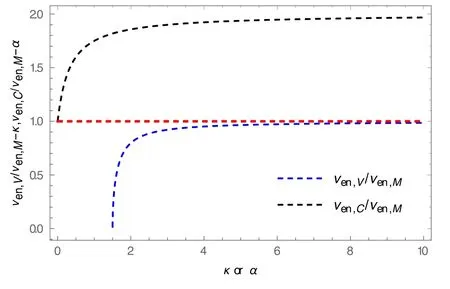
Figure 1.Dependence of the average collision frequency in (17) on the parameter κ and in (18) on the parameter α,respectively.
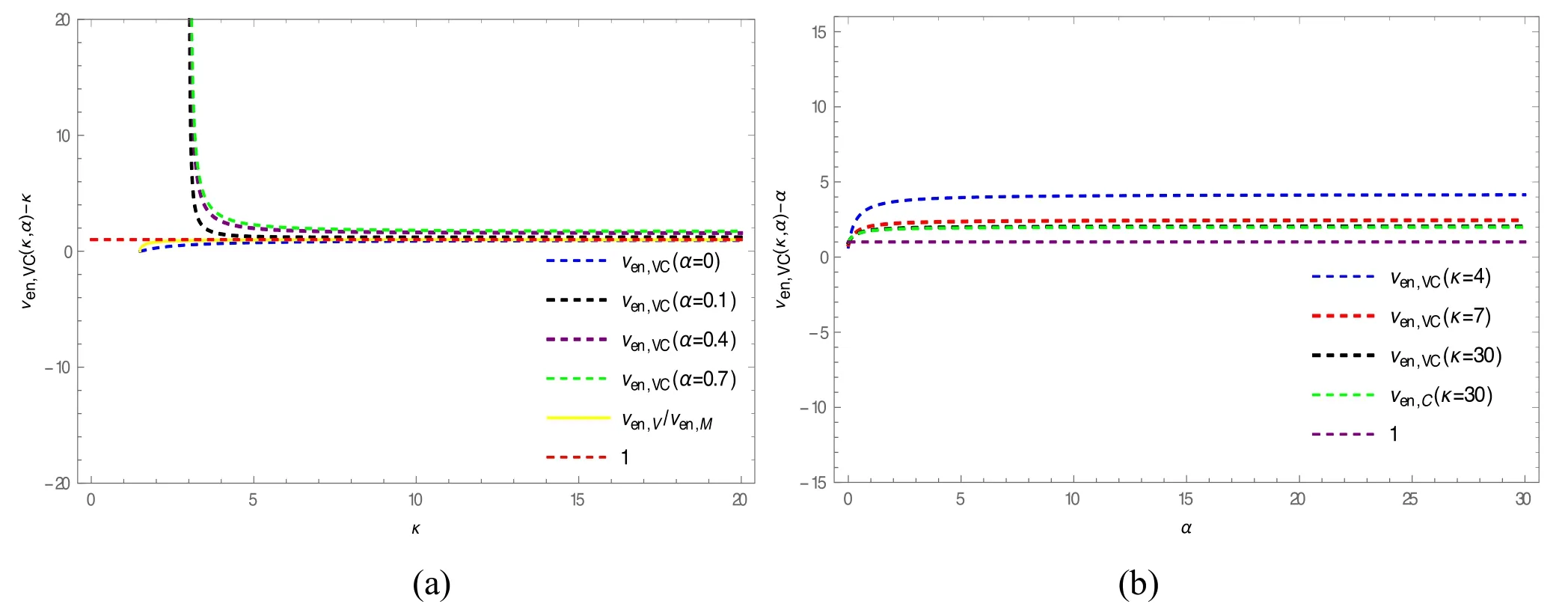
Figure 2.Dependence of the average collision frequency in (19) on parameters κ (a) and α (b).
From equations (19) and (16),we find that


From equations (20) and (16),we can find that

Based on equation (25),figure 3 numerically shows the effects of spectral indices r and q on the average collision frequency in equation(20).In figure 3(a)we took q as three fixed values of 1.5,2.2 and 5.4,respectively,and then changed the parameter r.It can be seen that as the value of r increases,en,(r,q)increases for the low values of r(viz,r < 5),and for large values of r with different q values,allen,(r,q)will approach a same constant.In figure 3(b),r was taken a fixed as 0,0.9,5 and 7.2,respectively,and the values of q changed.We notice thaten,(r,q)increases rapidly as the value of q increases when q is small,but it becomes constant when value of q is higher and it becomes independent of q.And with the increase of r,in the limit of q → ∞allen,(r,q)will approach the same constant.For this reason,we can give a mathematical expression by calculating the limit of equation (25) at r → ∞,as follows:
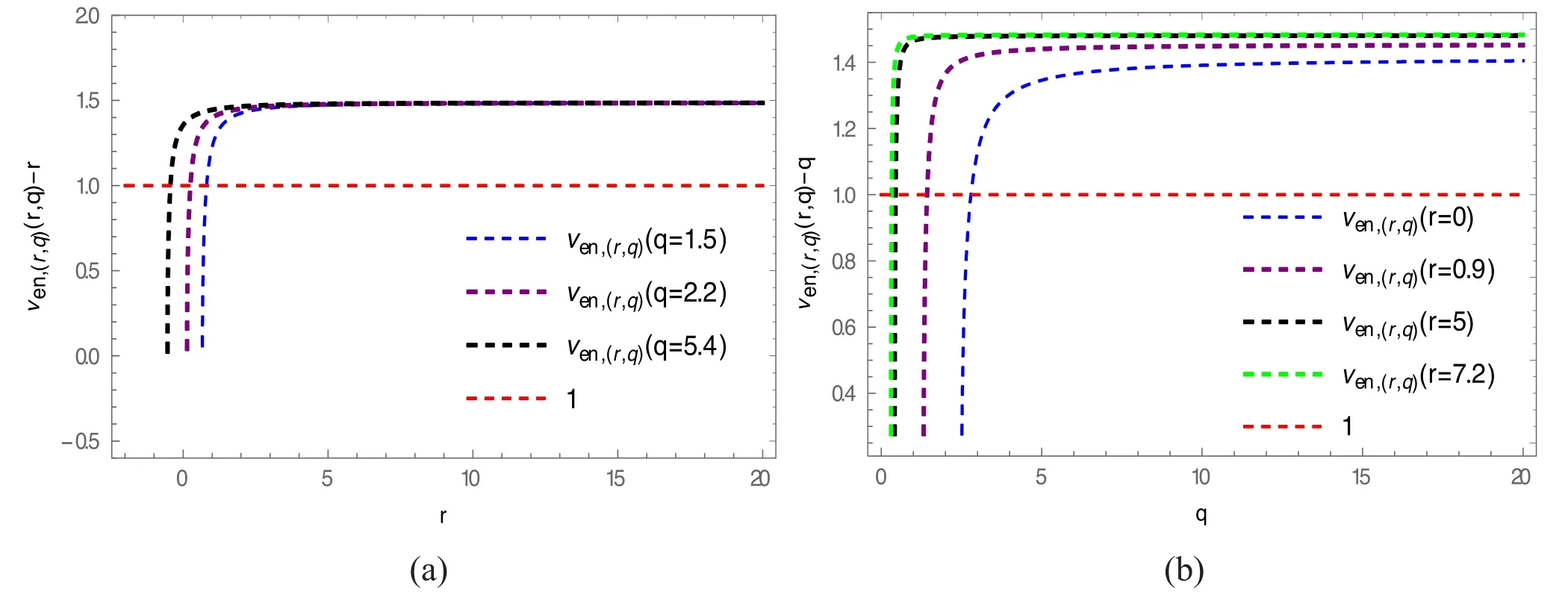
Figure 3.Dependence of the average collision frequency in equation (20) on the parameters r (a) and q (b).

Based on equations (21) and (16),the dependence ofen,AZon the spectral indices α,r and q are presented by

In order to illustrate our results more clearly,in figures 4(a)–(c),based on equation (27) we show the dependence of the average collision frequencyen,AZon the parameters α,r and q.From the figure 4(a) we show thaten,AZdecreases with the increase of the parameter q when α and r are fixed and α ≠0.When q increases to a certain value(related to the value of r and α),en,AZwill become a constant and independent of q.This is becauseen,AZtransforms intoen,(r,q)at α = 0,the curve ofen,AZis also infinitely close to that ofen,(r,q),as shown in figure 4(a),the black dotted line and the green dotted line are completely merged.
Figure 4(b)depicts that for fixed values of α(α ≠0)and q(viz,α = 0.8 and q = 1.5,α = 1.2 and q = 6),the frequencyen,AZdecreases with increase of the parameter r,and when r reaches a certain value,en,AZno longer changes with change of r.From the black and yellow curves in figure 4(b)it can be seen thaten,AZwill fall back toen,(r,q)for α = 0.In figure 4(c)we show thaten,AZdepends on α significantly when r and q are fixed.In this case,en,AZincreases rapidly with the increase of α in the range 0 < α < 5,and at α = 0,en,AZtakes the minimum value.When α is greater than a certain value(viz,α > 8),en,AZwill hardly change with α.In all cases,we find thaten,Mis generally smaller thanen,AZ.
5.Conclusion and discussion
In summary,we have investigated the average collision frequency of electron-neutral-particle in the weakly ionized complex plasmas with a variety of non-Maxwellian velocity distributions.We derived the expressions of the average collision frequency of electron-neutral-particle when the plasmas follow the kappa distribution,the Carins distribution,the Vasyliunas Carins distribution,the generalized two parameter (r,q)distribution,and the three-parameters AZ velocity distribution,respectively.They are given by the equations (17)–(21),respectively.We find that these average collision frequencies are all significantly dependent on the parameters in the complex plasmas with the non-Maxwell distributions.And only when these spectral indices(parameters)are the special cases,the collision frequencies in equations(17)–(21)can all return to the cases of the plasmas with the Maxwellian distribution perfectly.
In order to show the results more clearly,we have numerically analyzed the effects of the non-Maxwellian distributions on the average collision frequency of electron-neutral-particle in the weakly ionized complex plasmas.The results are illustrated in the figures (1)–(4) respectively.
We have shown that the frequencyen,Vin the plasma is generally smaller thanen,M,anden,Vincreases monotonously with the increase of the parameter κ at first and finally it approachesen,Mwith increase of κ.The frequencyen,Cdepends strongly on α when α is relatively small,and such dependence will be weakened gradually with the increase of α.
We have also shown that when α is fixed,the frequencyen,VChas a sharp decrease as the increase of the parameter κ in a small range of κ,and thenen,VChardly changes with κ.For a fixed value of κ,en,VCincreases sharply at the beginning and then approaches a constant gradually.
We have further shown the effects of r and q on the frequencyen,(r,q).It is found thaten,(r,q)increases as r increases when value of r is low,but when r exceeds a certain range,allen,(r,q)will approach the same constant.We can get the similar conclusion that the difference is thaten,(r,q)with different fixed r values will approach different constants when the value of q becomes high.

Figure 4.Dependence of the average collision frequency in equation (21) on the parameters α,r and q.
Finally,we have respectively studied the roles of the parameters α,r and q in the average collision frequency of electronneutral-particle in the complex plasma with the three-parameter AZ velocity distribution.If the parameters α and r are fixed,we show that when value of q is low,the frequencyen,AZdecrease monotonously with the increase of q and finally it approaches a constant.If the parameters α and q are fixed,we show that the effect of r onen,AZis similar to the effect of q onen,AZ.But if r and q are fixed,en,AZincreases monotonously with the increase of α when α is small.When α exceeds a certain value,en,AZwill also become a constant.We can obtain the following points:
(ii) for r → 0 and q = κ + 1,en,AZbecomesen,VC.
(iii) for α → 0 and r → 0 and q = κ + 1,en,AZbecomesen,V.
(v) for α → 0,r → 0 and q → ∞,en,AZbecomesen,M.
In conclusion,the average collision frequencies of electron-neutral-particle in the weakly ionized complex plasmas with the non-Maxwellian velocity distributions are generally and significantly different from those with a Maxwellian velocity distribution,and so the related transport properties in the complex plasmas are also different from those in the plasmas with a Maxwellian velocity distribution.
Acknowledgments
This work is supported by the National Natural science foundation of China under Grant No.11775156.
Appendix

where κ > 3 is required to ensure the convergence of the integral.

where q (1 + r) > 5/2 and q > 1 are required to ensure the convergence of the integral.
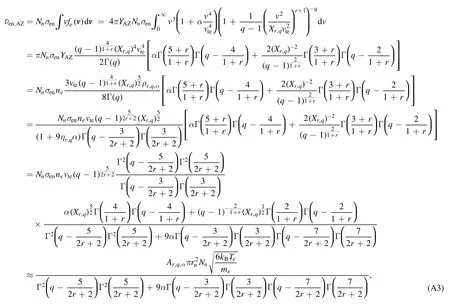
where q > 1,α > 0 and q (1 + r) > 5/2 are satisfied to ensure the validity of the integral.
杂志排行
Communications in Theoretical Physics的其它文章
- Monte Carlo study of the magnetic properties and magnetocaloric effect of an AFM/FM BiFeO3/Co bilayer
- Grüneisen ratio quest for self-duality of quantum criticality in a spin-1/2 XY chain with Dzyaloshinskii–Moriya interaction
- Quantum corrections to the entropy in a driven quantum Brownian motion model
- On a tilted Liouville-master equation of open quantum systems
- Electron Acceleration by a radially polarised cosh-Gaussian laser beam in vacuum
- Joule–Thomson expansion of RN-AdS black hole immersed in perfect fluid dark matter
